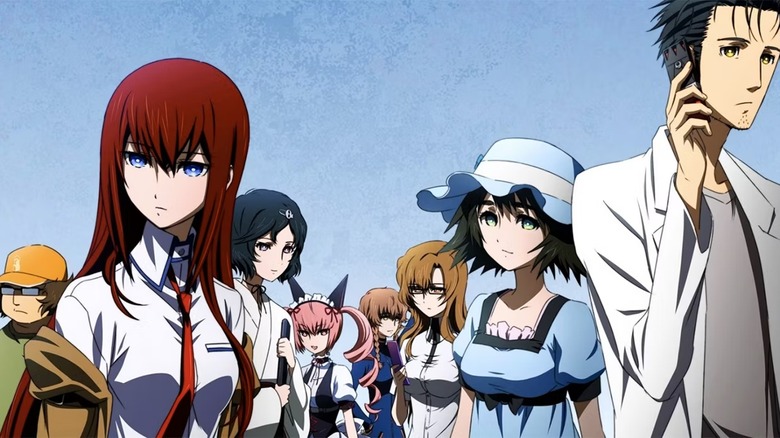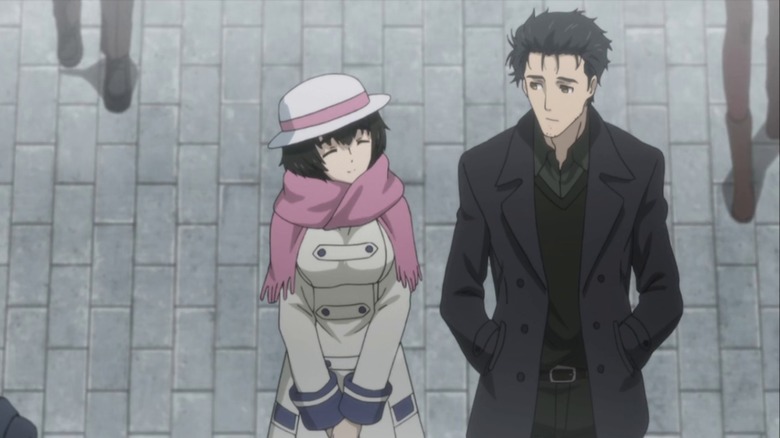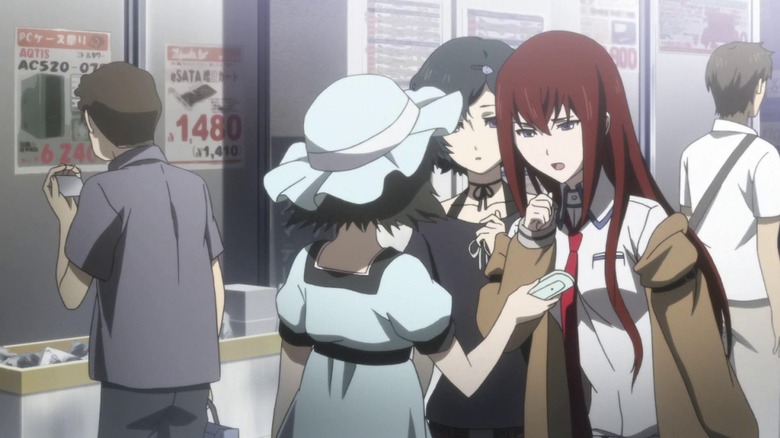The Correct Order To Watch STEINS;GATE (Including The Companion Film And Visual Novels)
This post contains spoilers for the "Science Adventure" series.
Time travel, although a purely theoretical thought exercise that is often given a creative spin, can become pretty convoluted. The visual novel format is well-suited for exploring such temporal conundrums, as the reader can pace themselves accordingly while the story branches into varying timelines and their repercussions. A good example is Konami's "Time Hollow," where we slip into the shoes of Ethan Kairos, who can use a Hollow Pen to open portals to the past. Unfortunately, the results are as painful as they can get, as time paradoxes are impossible to resolve when faced with a ticking clock.
When someone is given a literal pen to control the flow of time, things are bound to get messy; but what about temporal inconsistencies caused by the push of a button? Welcome to the world of "STEINS;GATE," where the harmless delusions of a self-proclaimed "mad scientist" inadvertently bear fruit after he experiences a mundane lecture on time travel.
Although the visual novels in the "Science Adventure" series — which "STEINS;GATE" is a part of — act as the perfect entry point for beginners, the anime series is a much more palatable way of immersing yourself in this intensely complicated world. The starting point will always be Rintaro Okabe, who loves referring to himself by his "true name," Kyouma Hououin, and we can hinge on his experience to move forward or backward in time to experience the events in their entirety.
There is obviously no harm done if you end up watching the anime in one go, but a more curated watch order, followed by the visual novels, will help you appreciate the nuances of a series that does not shy away from tackling heady ideas about string theory and collapsable wormholes.
The only correct watch order for STEINS;GATE
To make the best out of the clashing timelines, start with the 2011 anime, titled "STEINS;GATE," and watch episodes 1-22. The reason to break off after episode 22 is to understand what happens in the original timeline before diving into the temporal branching, as it helps us appreciate why Okabe and co. need to travel back in time to prevent the original events from occurring. Although the visual novels fill in the gaps present in the anime in greater detail, the lead-up to episode 22 provides us with the foundational knowledge about D-mails (DeLorean e-mails), the involvement of SERN, and how Okabe's repeated efforts to save Kurisu end in heartbreaking failure.
Next, watch episode 23β, an alternative take on events titled "Steins;Gate: Kyoukaimenjou no Missing Link –- Divide By Zero," which allows the events of "STEINS; GATE 0" to happen. Although brief, this special episode, released in 2015, epitomizes the most interesting facets of the franchise and lays the groundwork for the labyrinthine timelines and constant time hopping to unfold.
Now that you've watched episode 23β, time to watch 2018's "STEINS;GATE 0" in its entirety, which is considered the final iteration of Okabe's efforts to save Kurisu and the world at large. It is important to understand that the events in "STEINS;GATE 0" are crucial for the characters to achieve the end of their arcs in "STEINS; GATE," so this sequel is not skippable by any means.
With me so far? Great, now you can watch "Steins;Gate 0: Kesshou Takei no Valentine -– Bittersweet Intermedio," an optional OVA, which offers exactly what it promises: a Valentine's Special. It's a mostly lighthearted exploration of the dynamics in the Future Gadget Lab, which I would only recommend to completionists, as it does not add anything meaningful to the core events.
The STEINS;GATE time travel shenanigans continue
It's time to head back into the original "STEINS;GATE" anime and pick up right where we left off: episodes 23 and 24. These dual conclusive episodes help tie all loose ends for both the anime and "STEINS;GATE 0," effectively closing the temporal loop for an alternative timeline to be sustained. The culmination of Okabe's frustrating efforts comes to a bittersweet end, adding further pathos to the existential conundrums he wrestled with at different points in time.
Next up, we have "Steins;Gate: Egoistic Poriomania," a non-canon iteration of events that take place after the original series, which provides emotional closure for those seeking it. Okabe is finally able to express his feelings for Kurisu, and it is wonderful to witness how these characters have grown out of their limitations and come to terms with the timeline they end up cohabiting.
To wrap things up neatly, watch the 2013 companion film "Steins;Gate Movie: Load Region of Déjà vu," which takes place a year after the anime, with Okabe experiencing intense side-effects of time travel and visions of alternate worldlines. Okabe's sudden disappearance, like a person who never existed in the first place, is the impetus for this companion film, allowing Kirusu to be the one to bring him back to a timeline where he can exist, safe and sound. It is a beautiful, idealistic end to the series that is as much about loving someone against all odds as the mechanics of traveling through time and creating paradoxes in the process.
Last, but not least, we have the "Steins;Gate: Soumei Eichi no Cognitive Computing" OVA, which is entirely skippable, as they're basically advertisements in the form of shorts, but are enjoyable nonetheless.
The STEINS;GATE visual novels are integral to its identity
Establishing a timeline for the "Science Adventure" visual novels connected to "STEINS;GATE" can be tricky, as the best method would be to follow the release order, or play whatever piques your interest. Here's a list of all the visual novels that contribute to the convoluted yet essential worldbuilding of the series (in order of release):
-
"Chaos;Head" (2008)
-
"Chaos;Head Noah" (2009)
-
"Steins;Gate" (2009)
-
"Steins;Gate: My Darling's Embrace" (2011)
-
"Robotics;Notes" (2012)
-
"Steins;Gate: Linear Bounded Phenogram" (2013)
-
"Chaos;Child" (2014)
-
"Steins;Gate 0" (2015)
-
"Occultic;Nine" (2017)
-
"Steins;Gate Elite" (2018)
-
"Robotics;Notes DaSH" (2019)
-
"Anonymous;Code" (2022)
It's perfectly normal to feel a bit overwhelmed at first, but if you just want to stick to the very basics, start with 2008's "CHAOS;HEAD," which takes place in Shibuya in the year 2009 and follows Takumi Nishijou, an otaku shut-in with minimal interaction with the outside world. However, Takumi's peaceful world crashes down when he clicks on a link depicting an image of a real-life murder that is yet to occur. Some locations in this VN overlap with that of "STEINS;GATE," and it also features the same antagonist group: the Committee of 300.
Next, hop over to 2009's "STEINS;GATE," which got a revamped, animated overhaul with 2018's "Steins;Gate Elite." If you ask me, the 2009 version, although dated and much less visually interesting, employs a phone trigger system that impacts the plot and feels much more visceral. There is something more gripping about the events via text as opposed to animated cutscenes, which also have their own value, in case you want to play "Elite" right after.
Continue with 2012's "ROBOTICS;NOTES" and 2015's "STEINS;GATE 0" to complete the barebones VN arc, although these experiences can be time-consuming and emotionally taxing in their own right. A thorough enjoyment of "ROBOTICS;NOTES" hinges on references from both "CHAOS;HEAD" and "STEINS;GATE," so make sure to play through these VNs beforehand.
In case you do not want to play the offshoot VNs at all, wrap things up with 2022's "ANONYMOUS;CODE," which takes place in the year 2037 and is marked with chaos and death. It's an extremely thrilling experience that evokes pertinent existential questions and situates us in a post-apocalyptic setting with cyberpunk elements.
Alright, we're done! Make sure to be on the lookout for "STEINS;???" a yet-to-be-titled thematic "STEINS;GATE" sequel currently in development, with characters from the original VN reappearing in this entry. While we wait for this upcoming entry, immerse yourself in the beautifully chaotic world of "Science Adventure" visual novels — if you have the patience and time.



